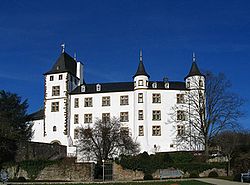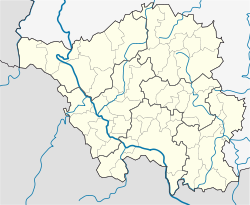
Saarland is a state of Germany in the south west of the country. With an area of 2,570 km2 (990 sq mi) and population of 990,509 in 2018, it is the smallest German state in area apart from the city-states of Berlin, Bremen, and Hamburg, and the smallest in population apart from Bremen. Saarbrücken is the state capital and largest city; other cities include Neunkirchen and Saarlouis. Saarland is mainly surrounded by the department of Moselle in France to the west and south and the neighboring state of Rhineland-Palatinate in Germany to the north and east; it also shares a small border about 8 kilometres long with the canton of Remich in Luxembourg to the northwest.

A Roman villa was typically a farmhouse or country house in the territory of the Roman Republic and the Roman Empire, sometimes reaching extravagant proportions.
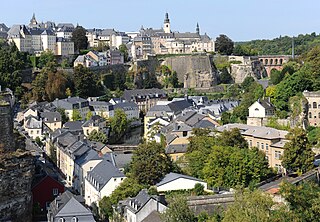
Luxembourg, also known as Luxembourg City, is the capital city of Luxembourg and the country's most populous commune. Standing at the confluence of the Alzette and Pétrusse rivers in southern Luxembourg, the city lies at the heart of Western Europe, situated 213 km (132 mi) by road from Brussels, 372 km (231 mi) from Paris, and 209 km (130 mi) from Cologne. The city contains Luxembourg Castle, established by the Franks in the Early Middle Ages, around which a settlement developed.

Saarbrücken is the capital and largest city of the state of Saarland, Germany. Saarbrücken is Saarland's administrative, commercial and cultural centre and is next to the French border.

The Moselle is a river that rises in the Vosges mountains and flows through north-eastern France and Luxembourg to western Germany. It is a left bank tributary of the Rhine, which it joins at Koblenz. A small part of Belgium is in its basin as it includes the Sauer and the Our.
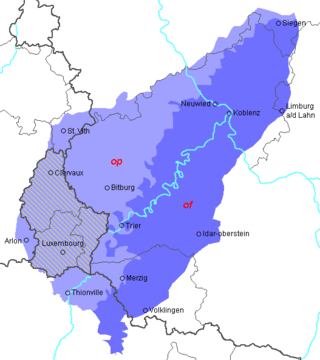
Moselle Franconian is a West Central German language, part of the Central Franconian languages area, that includes Luxembourgish. It is spoken in the southern Rhineland and along the course of the Moselle, in the Siegerland of North Rhine-Westphalia, throughout western Rhineland-Palatinate and Saarland, Luxembourg, the south of the German-speaking Community of Belgium and in the neighboring French département of Moselle. The Transylvanian Saxon dialect spoken in the Transylvania region of Romania is derived from this dialect as a result of the emigration of numerous "Transylvanian Saxons" between 1100 and 1300, primarily from areas in which the Moselle Franconian dialect was then spoken. Another variety of Moselle Franconian, the Hunsrik, is spoken in some rural areas of southern Brazil, brought by 19th century immigrants from the Hunsrück region in modern Germany.

Walferdange is a commune and small town in central Luxembourg.
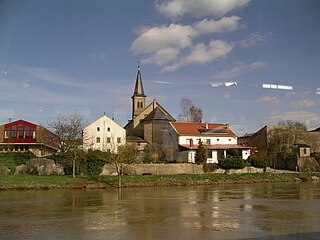
Perl is a municipality in Merzig-Wadern, Saarland, Germany. In 2020 its population was 8,824.

SaarLorLux or Saar-Lor-Lux, a portmanteau of Saarland, Lorraine and Luxembourg, is a euroregion of five regional authorities located in four European states. The term has also been applied to cooperations of several of these authorities or of their subdivisions, administrations, organisations, clubs and people. Member regions represent different political structures: the sovereign state of Luxembourg; Belgium's Walloon region, comprising the French and German speaking parts of Belgium; Lorraine, a region of France; the French départements Moselle and Meurthe-et-Moselle; and the German federated states of Saarland and Rhineland-Palatinate.

Contz-les-Bains is a commune in the Moselle department in Grand Est in north-eastern France.
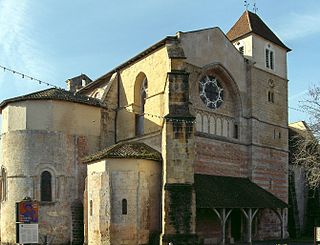
Sorde-l'Abbaye is a commune, in the department of Landes and the region of Nouvelle-Aquitaine in southwestern France.

Villa rustica was the term used by the ancient Romans to denote a farmhouse or villa set in the countryside and with an agricultural section, which applies to the vast majority of Roman villas. In some cases they were at the centre of a large agricultural estate, sometimes called a latifundium. The adjective rustica was used only to distinguish it from a much rarer sub-urban resort villa, or otium villa built for purely leisure and luxury, and typically located in the Bay of Naples. The villa rustica would thus serve both as a residence of the landowner and his family and also as a farm management centre. It would often comprise separate buildings to accommodate farm labourers and sheds and barns for animals and crops.
The Saar Treaty, or Treaty of Luxembourg is an agreement between West Germany and France concerning the return of the Saar Protectorate to West Germany. The treaty was signed in Luxembourg on October 27, 1956, by foreign ministers Heinrich von Brentano of West Germany and Christian Pineau of France, following the Saar Statute referendum on October 23, 1955, which resulted in a majority vote against the Saar Statute.

The Roman Villa Borg is a reconstructed Roman villa rustica located near the villages of Borg and Oberleuken in the municipality of Perl in Saarland, Germany. Discovered at the end of the 19th century, the site was excavated in the late 1980s. Reconstruction work, which began in the mid-1990s, was virtually completed in late 2008 although further excavation work is still continuing. The site is a popular tourist attraction with some 50,000 visitors per year.

Borg is a German village in the municipality of Perl, Saarland. It is located 5 km north east of Perl and 11 km south west of Nennig on the River Mosel. It lies at a height of 355 m and has a population of 370. The nearby Roman Villa Borg is one of the Saarland's most important archaeological sites.

Luxembourg art can be traced back to Roman times, especially as depicted in statues found across the country and in the huge mosaic from Vichten. Over the centuries, Luxembourg's churches and castles have housed a number of cultural artefacts but these are nearly all ascribed to foreign artists. The first examples of art with a national flavour are paintings and maps of the City of Luxembourg and its fortifications from the end of the 16th until the beginning of the 19th century, although these too were mostly created by foreign artists. Real interest in art among the country's own citizens began in the 19th century with paintings of Luxembourg and the surroundings after the country became a grand duchy in 1815. This was followed by interest in Impressionism and Expressionism in the early 20th century, the richest period in Luxembourg painting, while Abstraction became the focus of art after the Second World War. Today there are a number of successful contemporary artists, some of whom have gained wide international recognition.

The Thionville–Trier railway connects Thionville in the French region of Grand Est with Trier in the German state of Rhineland-Palatinate. It also passes through the westernmost part of the Saarland along the Moselle for a few kilometres.

The Saargau was a Frankish Gau county (Gaugrafschaft). Today the name is given to the ridge between the rivers Saar and Moselle in Germany and, in the south, the region between the Saar and the French border.

Johann Viktor, known professionally as Johannes "Joho" Hoffmann, was a German politician. A founding member and chairman of the Christian People's Party, Hoffman served as Minister-President of the French Saar Protectorate from 1947 to 1955.

Germany and Luxembourg first established bilateral relations in April 1951. The two countries have shared a peaceful and friendly relationship over their 72 year relationship, especially through their mutual cooperation in international organisations such as the European Union, NATO, the OECD and the United Nations.
